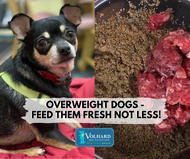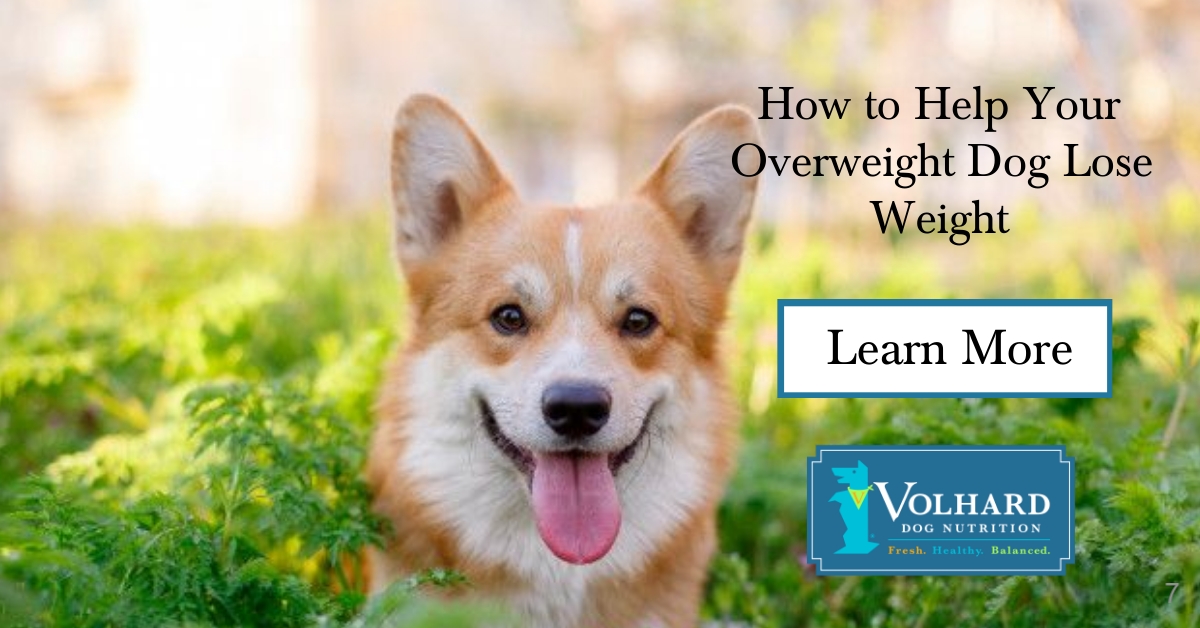Overweight Dogs - Feed Them Fresh Not Less!
Posted by Jennifer Carter on Dec 12th 2019
You’ve reduced the amount you feed your dog, switched them to kibble for obese dogs, and maybe even tried
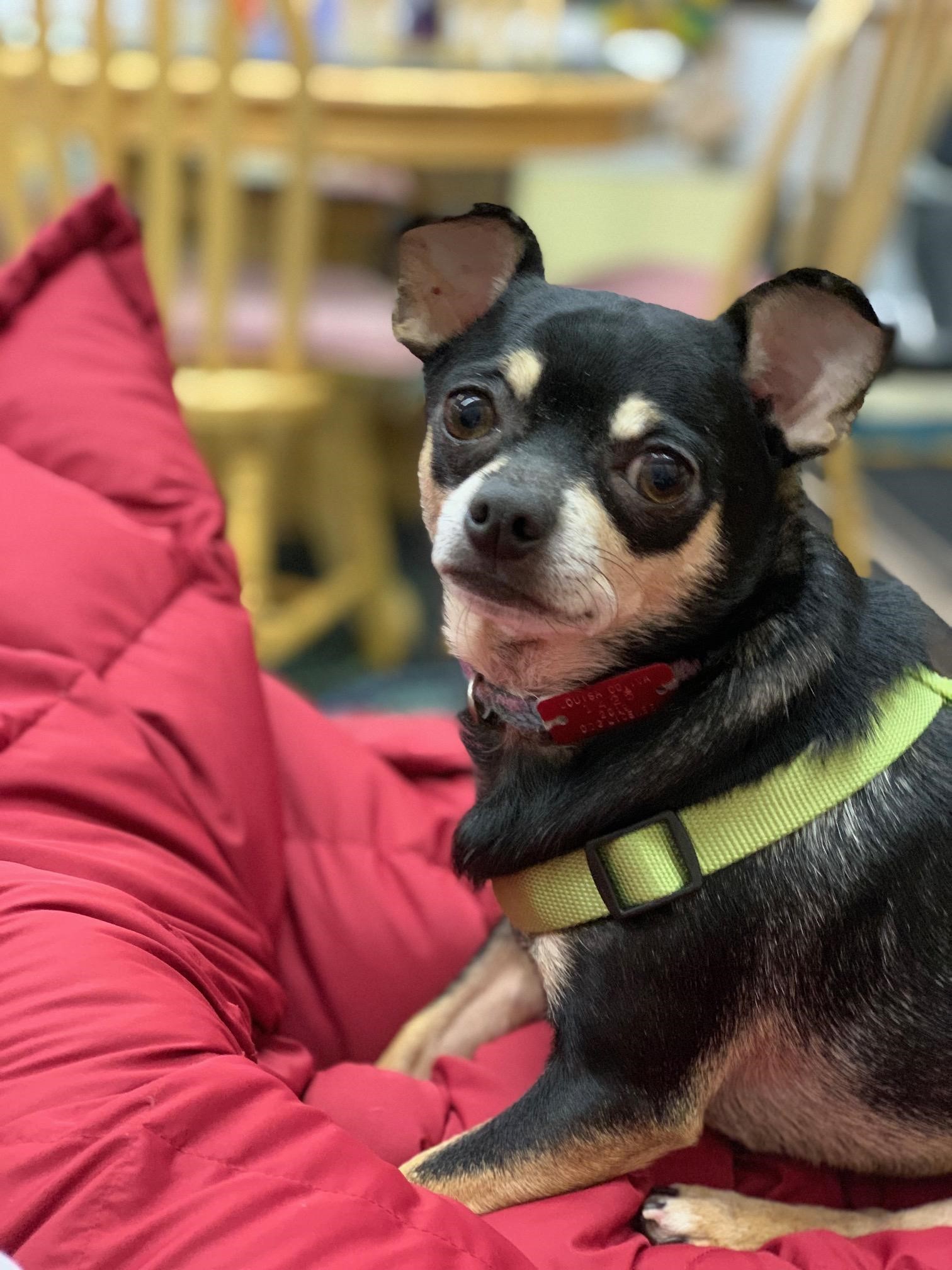
weight-loss pills or natural supplements. You feel like you’ve tried everything, but nothing has worked. Don’t give up just yet — you’re ignoring the best diet for overweight dogs: the fresh diet.
I met Bobo and his family about 6 months ago when they relocated to Virginia. Bobo is a spirited 3-year-old purebred Chihuahua who was rescued by his parents around age 1. He was absolutely charming so I was very motivated to help him be the healthiest version of himself.
The first thing I noticed about Bobo was that he was overweight for his breed and size. He weighed 12.3 lbs and you could see the extra weight gathering around his chest, neck and rump area. You could not move his skin, he was heavy like a brick and panted heavily after short play.
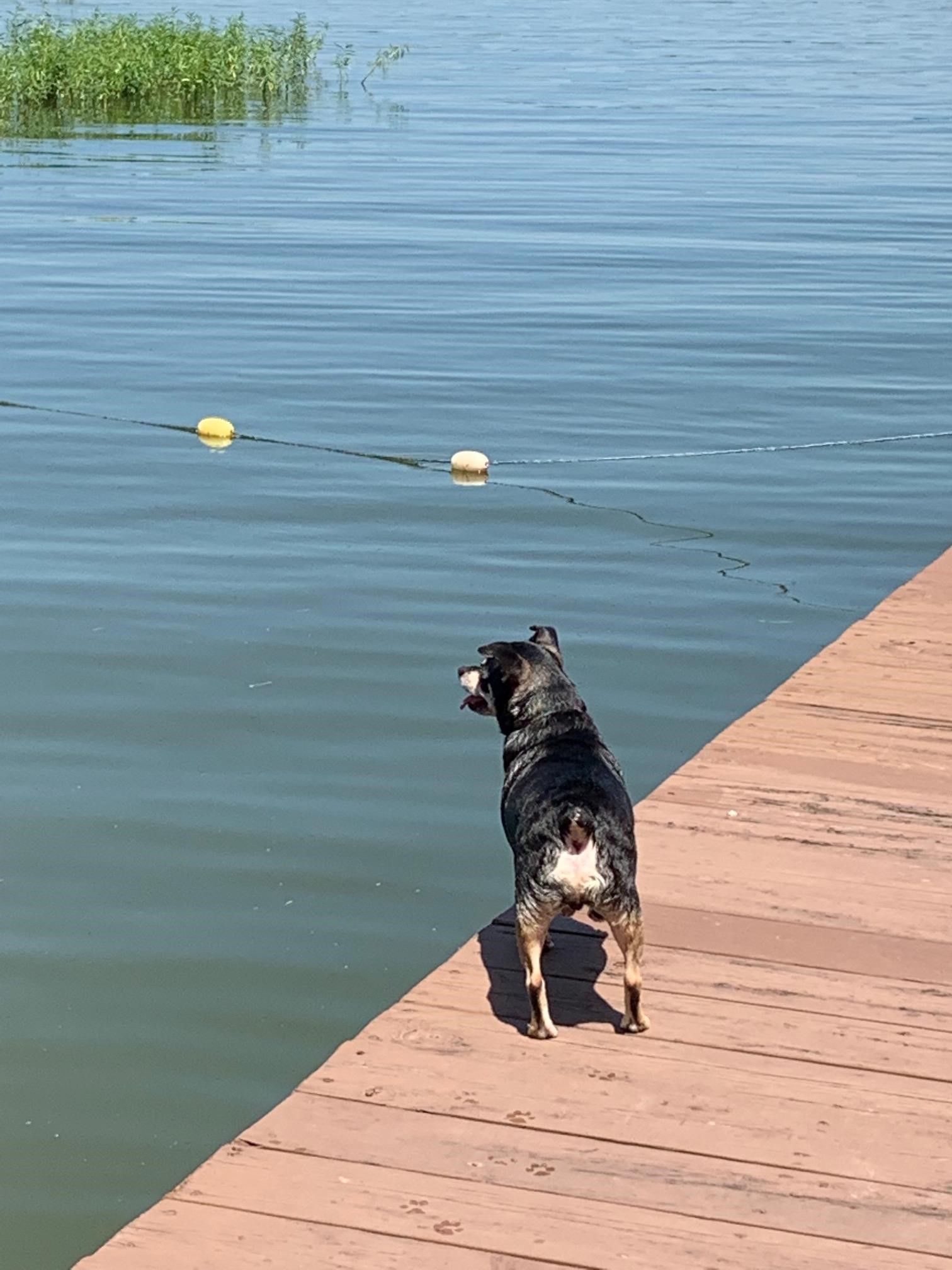
I asked his owner if they would be willing to change his diet from dry kibble and *extras* to the Volhard NDF2 diet with raw 80/20 beef. They were worried that he might not eat it because he was a little picky and they had never fed raw to their dogs before. After a nice consultation, they agreed and we began the transition. In addition to the diet transition, I also changed Bobo’s treats from the dollar store style treats to a higher quality coconut treat which was more size appropriate for this dog’s needs. We also added a Volhard Digestive enzyme with pre and probiotics to help diversify Bobo’s gut microbiome so he could get the most nutrition out of his food and have a strong immune system.
In this blog, I am going to talk about Bobo’s successful weight loss journey using the Volhard NDF2 fresh diet over the timespan of 6 months. Bobo was not exhibiting overt health problems as a 3-year-old dog, but as you can expect his activity levels would not increase as he ages so it is best to address this in a young dog right away if you can. Before we dig into Bobo’s specific experience, I think it is important to understand why obesity in dogs is detrimental, how to know if your dog is too fat, how dogs get fat and what role the gut microbiome plays in the obesity puzzle. Let’s start here-dogs are fat for these basic reasons:
●They are being fed a diet consisting of 50% cereal (i.e. 50% carbohydrates): This would be the case in many dry fed dogs diets and is very contrary to what a dog would normally eat, given the chance.
●They are being fed high in fat “pet” mince of “beef”, “lamb”, “rabbit” or “venison”: This type of meat is usually for an incredibly low price which meats do not normally cost. How do you think they are able to charge these low prices? One way is by finely grinding carcass and selling it as “meat” (buyers do not easily notice the difference). However, the common way is by using fat and blood as the main constituents (this looks exactly like minced meat).
●The dog is not as active as usual (getting old, injured or bad weather) and is being fed too much food for their activity levels: It is important to keep an eye on your dog’s activity levels and adjust their dietary intake if they have slowed down for any reason. It is also worthwhile paying attention to how many treats they are given as too many can lead to an increase in body weight.
●Dogs that are neutered or spayed retain more fat due to hormonal disruption, mainly the removal of testosterone and estrogen.
So just how bad is the obesity problem in dogs? Is my dog the only one?
According to veterinarians across the U.S., more obese dogs than ever are showing up in their clinics and the trend does not appear to be slowing. It is not surprising that excess weight can take as much of a toll on a dog’s body as it does on a human’s body. While some of the effects of obesity can be reversed through attentive diet changes and increased physical activity, there is some damage that can only be mitigated by the change of habits. Some damage will remain for life, and the longer the excess weight is on the body, the more severe the damage to the body will be. Obesity figures are soaring in dogs, from approximately 22% of the dog population in the 1980s (Edney and Smith 1986, Donoghue et al. 1991) up to 40% of dogs in Western countries today (McGreevy et al. 2005). Coincidentally, this matches the increased usage of commercial dry food which contains a belly-busting 50-60% cereal (wheat/corn). And we wonder why we have so many fat dogs?
How do I know my dog is overweight?
Many dog owners will not notice their dog has been gradually putting on extra weight until the dog starts slowing down significantly. More often it is the animal’s regular groomer or veterinarian that will notice your dog’s physical changes. To do a check on your dog, feel around its midsection while your dog is standing. The ribs and spine should be easy to feel, and on most dogs, there should be a tucked in, or slight hourglass shape to the waist. If you cannot easily feel your dog’s ribs or spine, and the tucked-in waist has thickened considerably enough to give the animal a more tubular shape, it is time for you to think about a weight loss regimen for your dog.
Check out this diagram to help you check your dog for appropriate weight:
What issues are caused by excess weight?
Excess weight can cause dogs discomfort, and obesity can bring on serious health problems. Here are some of them:
●Trouble breathing
●Lung problems
●Sore joints and orthopedic issues
●Torn cruciate ligaments (similar to the ACL in humans)
●Hip dysplasia
●Arthritis
●Immune system problems
●Skin problems
●Heart problems
●High blood pressure
●Greater risk of heat stroke
●Pancreatitis
●Diabetes
●Reduced lifespan
Doesn’t that list make you want to put your faithful friend on a diet? All of these conditions reduce the lifespan of your dog and decrease her quality of life.
The Gut Microbiome- Why Feeding Fresh Matters!
What’s helping the scale creep upward? Is it your pet’s genetics, diet, or activity levels? Or could it be their gut microbes (the balance of good and bad bacteria)? The gut microbiota of dogs is significantly influenced by diet type (i.e., fresh food diet and commercial feed). Specifically, dogs fed a fresh diet have a more diverse and abundant microbial composition in the gut microbiota than dogs fed a commercial feed grade diet. The type of diet might, therefore, play a key role in dog health by affecting the gut microbiota. The ratio of proteins and carbohydrates in a dog's daily diet has a significant influence on the balance of microbes in its gut.
Changing your dog’s diet can alter the bacteria that reside in their gut because different species thrive in different conditions. So, it makes sense that feeding your dog a diet high in carbohydrates would benefit distinct species compared to a diet high in protein. When the types of bacteria that make up the gut microbiome shift, that can change what nutrients are processed and how your pet gets energy. Scientists think that gut bacteria in obese animals are more efficient at extracting and storing energy from food.
So a fresh diet is more diverse in living bacteria and offers your dog those living bacteria to populate their guts. Volhard used the AnimalBiome test to test the microbiome and in the report, we learned some very important things. AnimalBiome educated us that greater richness, evenness, and diversity of gut bacteria are associated with better health and digestion. Lower diversity is associated with a number of health conditions, including Inflammatory Bowel Disease and obesity. Here are the top 3 types of bacteria that Animal Biome identify as having an immediate effect on a dog’s weight:
●The most common bacterial phyla found in dogs, cats, and people are the Bacteroidetes and the Firmicutes. A number of studies have explored the relationship between the ratio of Firmicutes to Bacteroidetes (F:B) and obesity. F:B ratios tend to be higher in dogs that consume more carbohydrates. Bacteria belonging to the Bacteroides genus help prevent harmful bacteria from colonizing in the gut. Dogs with more of these bacteria tend to have healthier body weights. *bacterial description taken from a typical AnimalBiome report. https://www.
●Bacteria belonging to the Megamonas genus help regulate your dog's metabolism. Megamonas bacteria kick into high gear if your dog stops eating or is unable to absorb nutrients from their food; in these cases, the Megamonas bacteria help preserve energy so your pet does not lose weight. When too much Megamonas bacteria is present, however, it can make your pet more prone to becoming overweight. *bacterial description taken from a typical AnimalBiome report. https://www.
●Bacteria belonging to the Peptoclostridium genus help protect your pet against a number of intestinal pathogens, including Clostridium difficile and certain harmful strains of Escherichia coli. Pets with healthy levels of Peptoclostridium tend to have healthier immune and digestive systems. These bacteria may be deficient in overweight or obese pets. *bacterial description taken from a typical AnimalBiome report. https://www.
If you are concerned about an obese dog, trying a prebiotic that supports bacteria that produce short-chain fatty acids, a byproduct bacteria make when breaking down fiber, could help. These byproducts are thought to help humans feel full, which, if also true in pets, might make your dog eat less. A change in diet could also help shift the microbiome toward bacteria that are found in lean individuals.
Bobo’s Journey to the Appropriate Weight
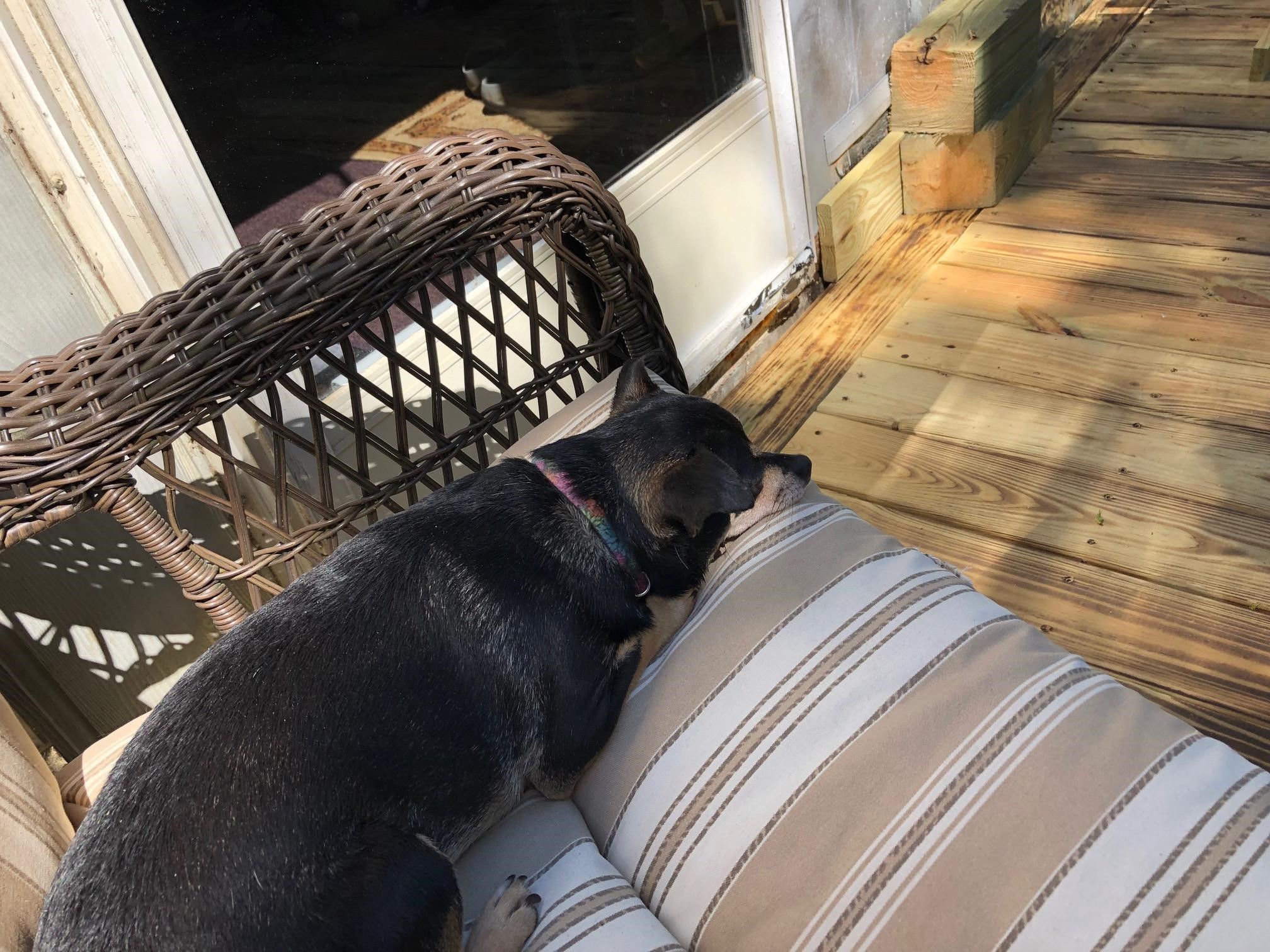
On July 26, 2019, we weighed Bobo in the morning before breakfast and he was 12.3 lbs. Bobo’s extra weight could be seen in his shoulders and neck, around his chest, and on his rump. When you felt him, he felt very solid and his skin hardly had movement. You could feel a fat pad around his ribs and his tail (which is docked) could be seen moving slowly with the extra weight around it.
Bobo has a very large body compared to his head. His shape was sausage-like and he had no physical signs of muscularity. His hair was coarse and dull. His teeth had tartar buildup.
Bobo’s target weight was 10 lbs. We did not want him losing too much weight too fast as that can also put a tremendous strain on a dog’s system. We wanted him to lose 2-3 lbs comfortably and then we planned to re-measure him using the body condition scoring chart to see if we needed him to lose more or start a maintenance feeding program. We weighed Bobo every time at the same time of day using the same scale.
Results:
For the first 3 months, Bobo lost no weight. His metabolism was just stuck and although we had increased his activity levels he remained 12 lbs. What we did see immediately from the diet was a change in the texture and shininess of his coat and his cleaner teeth. Bobo’s fur is coarse in texture, but after 1 month on the diet it felt much softer and the coloring improved from a dull black to a nice shiny healthy black.
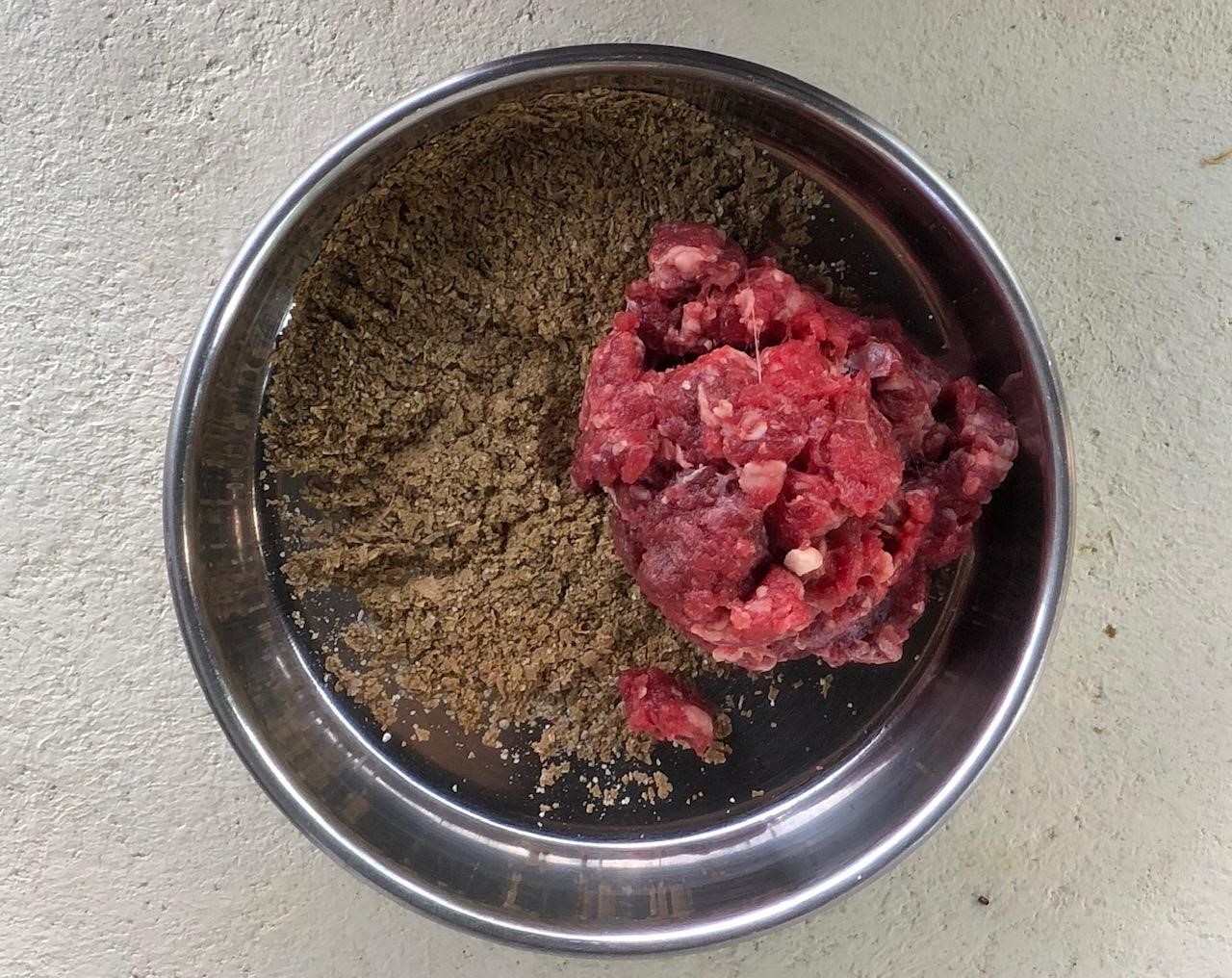
Bobo was fed 1 TBSP of NDF2 and 1 TBSP of 80/20 beef 2x/day 6 days a week and then mackerel on the 7th day as the protein and about 4 months into his journey his metabolism kicked in. He ate his meals within an 8 hour period and then intermittently fasted overnight without missing meals. He was given small coconut treats a few times a day.
Because NDF2 is calorically dense versus that of kibble, we were able to feed much less and reach the necessary caloric needs of the dog without issue. Vets consider portion control better than worrying about reducing calories. Feeding your dog the right amount of satisfying healthy, fresh and balanced food containing healthy fats will help your dog feel satisfied with potentially less food as well as reduce begging.
We considered the treats as a portion of the daily food allowance. We also offered Bobo treats that were vegetables and fruits, like blueberries and apples. I helped the family stay firm when Bobo began to beg. Your dog may shadow you in the kitchen. They may whine and cry. But you have to resist the temptation to indulge them.
Feeding fresh means no free-feeding so you put the food down in front of the dog, they eat and feeding time is over. The ducks don’t line up on the shore of the pond for the coyote at dinner time, and the wolf doesn’t munch caribou cutlets like mints in a candy dish. Dogs don’t eat whenever they want in the wild, and neither should the dog in the home.
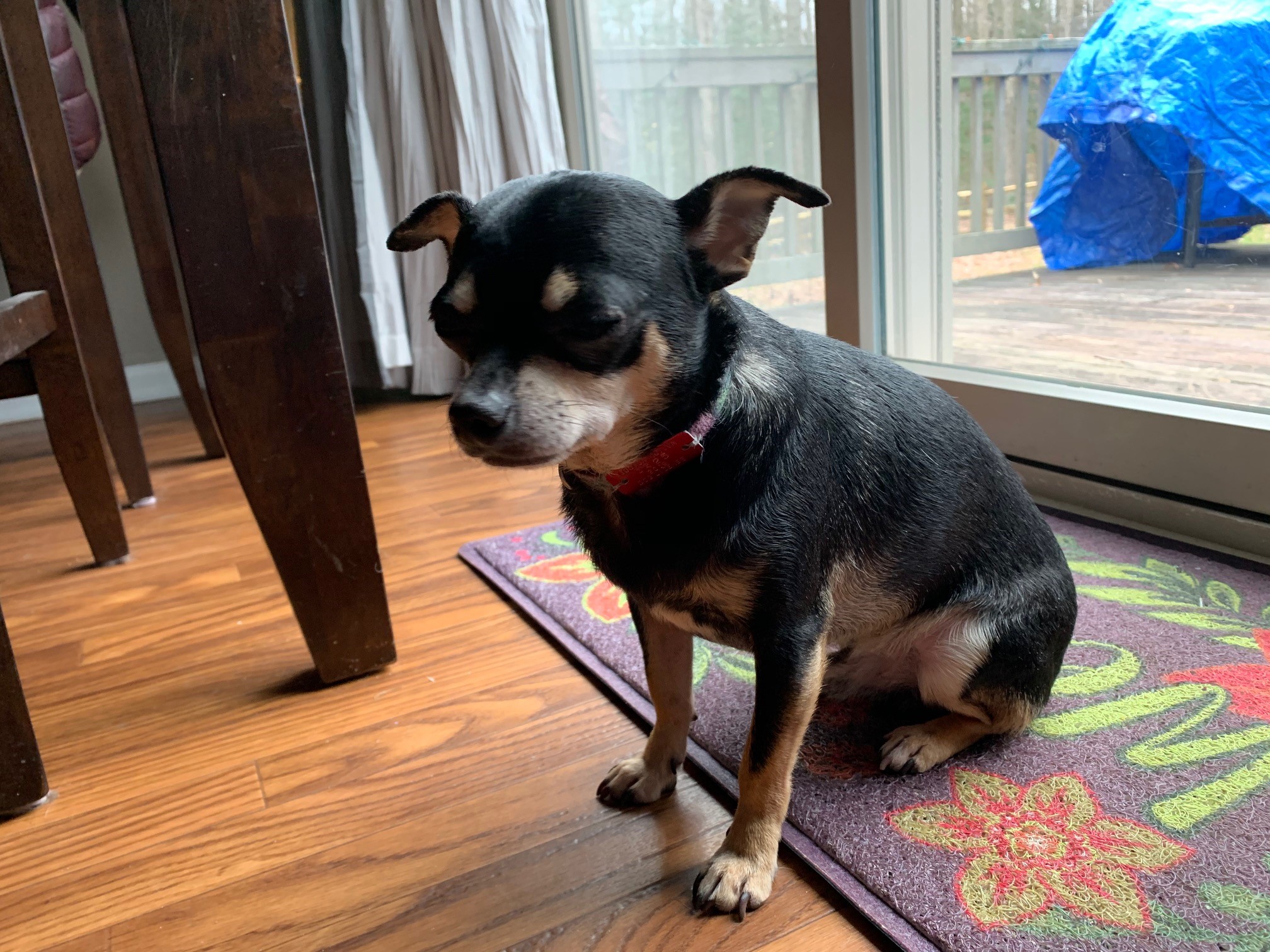
Finally, by calculating daily calories, we were able to get Bobo to lose weight. It’s important to properly crunch the numbers if you want to reduce or maintain.
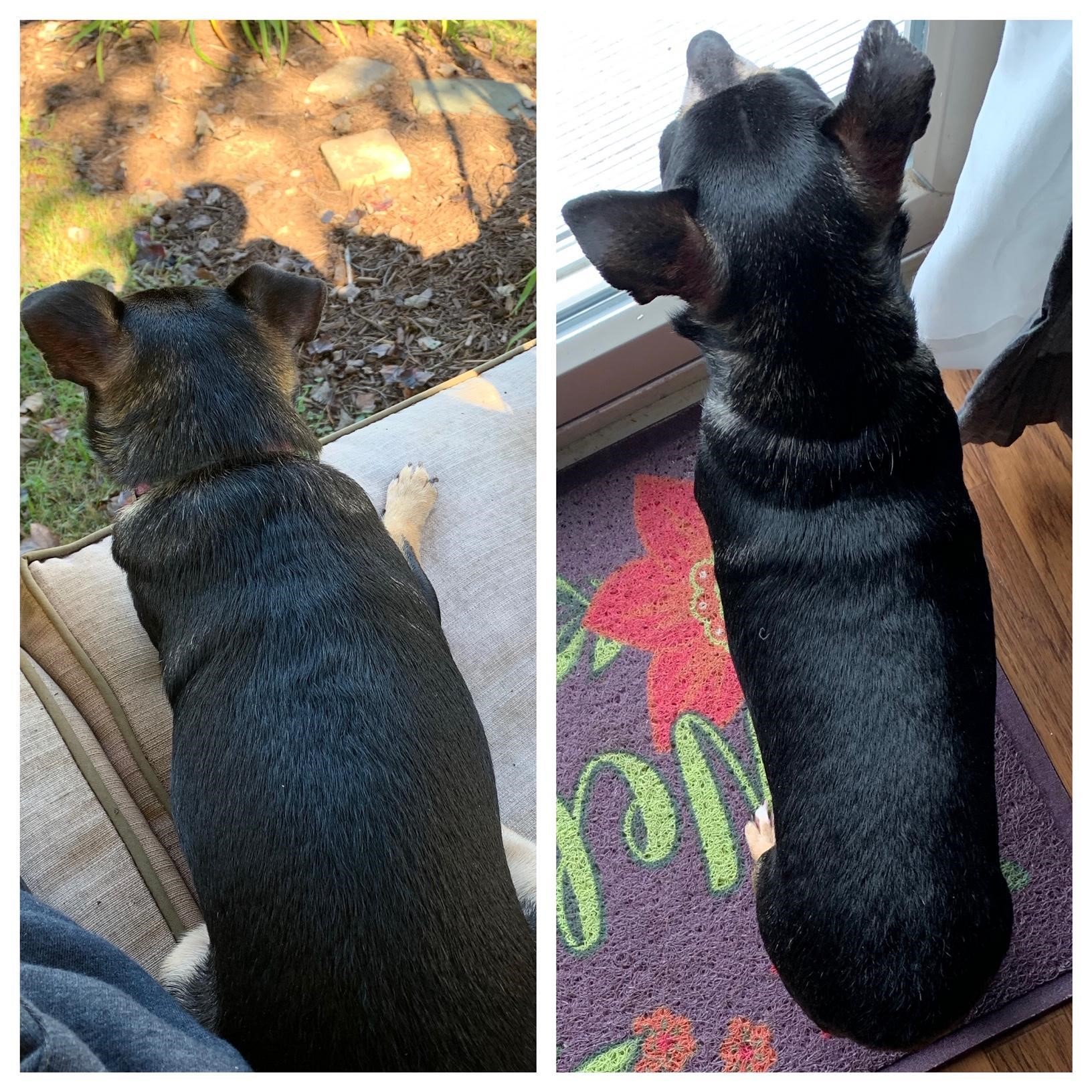
The picture on the left is before fresh feeding began and the right shows marked improvement in shape, leanness, and muscularity. In the picture on the left Bobo weighed 12.3 lbs and the picture on the right Bobo now weighs 10.2 lbs. His activity levels improved, little to no panting after big runs and his legs are stronger and more muscular. We We can feel his ribs through his skin and we can roll his skin all along his back now.
The top picture shows panting just standing still with minimal play. You can see the larger rolls along the neck, the lack of indentation where the leg meets rump, the sway in the back and his little out of proportion head. The bottom picture reveals some new muscularity including the indentation of the leg at the rump, minimized rolls of skin with less lumpiness and a
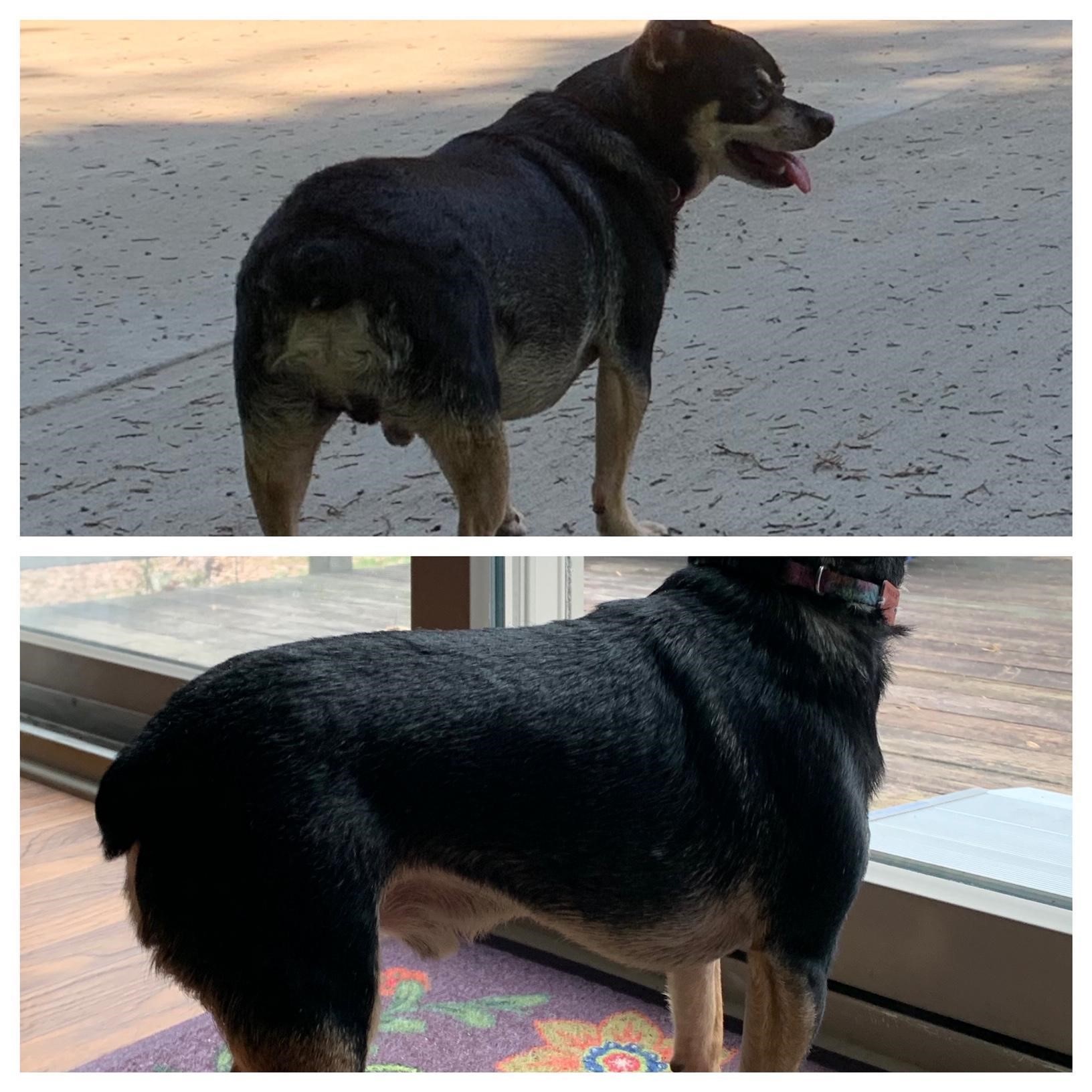
beautiful tuckup.
A healthy weight loss is typically 1 to 5 pounds per month based on your dog's size and current condition (weight loss of 3 to 5+% of body weight per month based on age and current physical condition). Some dogs may need to lose weight slower while others may reduce excess weight more quickly. 2-3 lbs on a small dog is a lot of weight and we are happy to see Bobo reach his goals! The change in diet, increased activity levels, and portion control allowed Bobo to lose the weight he needed to safely and help him become a healthier, happier dog.
References
Association for Pet Obesity Prevention. Association for Pet Obesity Prevention Available at: https://petobesityprevention.org/. (Accessed: 24th March 2019)
Deng, P. & Swanson, K. S. Gut microbiota of humans, dogs and cats: current knowledge and future opportunities and challenges. Br. J. Nutr. 113 Suppl, S6–17 (2015).
Donoghue, S., Khoo, L., Glickman, L. T. and Kronfeld, D. S. (1991). Body condition and diet of relatively healthy older dogs. Journal of Nutrition, 121: S58–S59.
Edney, A. T. B. and Smith, P. M. (1986). Study of obesity in dogs visiting veterinary practices in the United Kingdom. Veterinary Records, 118: 391–396.
Fascetti, A.J. And Delaney, S. J. (2012). Applied Veterinary Clinical Nutrition. John Wiley and Sons. Chapter 10. Nutritional Management of Orthopaedic Diseases by Herman Hazelwinkel.
Fischer, M. M. et al. Effects of obesity, energy restriction and neutering on the faecal microbiota of cats. Br. J. Nutr. 118, 513–524 (2017).
Fleeman, L. and Rand, J. (2005). Beyond insulin therapy: Achieving optimal control in diabetic dogs. Brisbane, Australia: Centre for Companion Animal Health, University of Queensland.
German, A. J. (2006). The growing problem of obesity in dogs and cats. Journal of Nutrition, 136: 1940S–1946S.
German, A. J., Holden, S. L., Bissot, T., Morris, P. J. & Biourge, V. A high protein high fibre diet improves weight loss in obese dogs. Vet. J. 183, 294–297 (2010).
Kasstrom, H. (1975). Nutrition, weight gain and development of hip dysplasia. Acta Radiologica, 334: S135–179.
Kealy, R. D., Olsson, S. E., Monti, K. L., Lawler, D. F., Biery, D. N., Helms, R. W., et al. (1992). Effects of limited food consumption on the incidence of hip dysplasia. Journal of the American Veterinary Medical Association, 201: 857–863.
Lawler, D. F., Larson, B. T., Ballam, J. M., Smith, G. K., Biery, D. N., Evans, R. H., et al. (2008). Diet restriction and ageing in the dog: Major observations over two decades. British Journal of Nutrition, 99: 793–780.
Ley, R. E. Obesity and the human microbiome. Curr. Opin. Gastroenterol. 26, 5–11 (2010).
Loftus, J. P. & Wakshlag, J. J. Canine and feline obesity: a review of pathophysiology, epidemiology, and clinical management. Vet Med (Auckl) 6, 49–60 (2015).
Lund, E. M., Armstrong, J. P., Kirk, C. A. and Klausner, J. S. (2006). Prevalence and risk factors for obesity in adult dogs from private US veterinary practices. Journal of Applied Research Veterinary Medicine, 4(2): 177–186.
McGreevy, P. D., Thomson, P. C., Pride, C., Fawcett, A., Grassi, T. and Jones B. (2005). Prevalence of obesity in dogs examined by Australian veterinary practices and the risk factors involved. Veterinary Records, 156: 695–707.
Omer, E. & Atassi, H. The Microbiome That Shapes Us: Can It Cause Obesity? Curr. Gastroenterol. Rep. 19, 59 (2017).
Turnbaugh, P. J. et al. An obesity-associated gut microbiome with increased capacity for energy harvest. Nature 444, 1027–1031 (2006).

